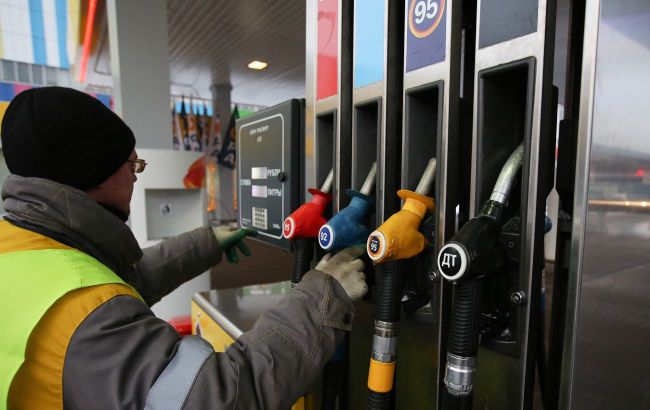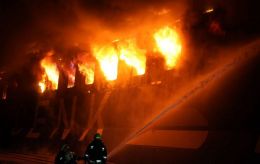Fuel crisis in Crimea: How refinery attacks hit Russia's economy
 Fuel crisis across Russia (Getty Images)
Fuel crisis across Russia (Getty Images)
Due to Ukrainian drone strikes on Russian oil refineries in Crimea, the fuel shortage has worsened even further.
How the Armed Forces of Ukraine are destroying Russia’s oil refining and whether a shortage of fuel in the Russian army is possible – in the material of RBC-Ukraine.
On Wednesday, October 1, residents of occupied Crimea faced new restrictions on fuel sales. The maximum volume of gasoline available for purchase by one car owner was limited to 20 liters.
"A decision has been made to limit the volume of fuel sales – no more than 20 liters per person. At the same time, public transport, social facilities, utility, and emergency services are fully supplied," declared the so-called head of Crimea, Sergey Aksyonov.
Crimea’s gas stations did not cope with providing the population with larger volumes of fuel (under previous restrictions). Obviously, with the new, even stricter restrictions, the situation will not improve, as the batch of fuel recently delivered to the peninsula was almost completely sold out, he complained.
Which capacities have been disabled
Revenues from oil and gas exports account for about a quarter of Russia’s budget, which this year enabled the Kremlin to increase military spending by 25% – the highest level since the Cold War.
At the same time, Ukrainian drone attacks on Russia’s oil and gas infrastructure have turned into a systemic campaign aimed at the foundation of the aggressor country’s economy. Russia’s losses from these strikes have already reached about $100 billion, writes The Sun.
The attacks not only create problems in the daily lives of Russians but also lead to fuel shortages, which significantly limit the Kremlin’s ability to continue the war against Ukraine, military expert Philip Ingram said to the media outlet.
Over the past few months, several large enterprises have been targeted, including Lukoil plants in Volgograd, Rosneft in Ryazan, as well as facilities in the Rostov, Samara, Saratov, and Krasnodar regions.
The Druzhba pipeline and the export terminal in the city of Ust-Luga of the Novatek company, as well as other fuel infrastructure facilities of the aggressor country, have also suffered damage.
A noticeable effect comes from strikes on oil refineries, which inflict the greatest damage on Moscow. Before the start of the full-scale invasion, energy exports formed about 40% of Russia’s budget, now about 30%.
At least 17% of refinery capacities have been disabled, corresponding to approximately 1.1 million barrels of oil per day, according to calculations by Reuters analysts.
In September, the gasoline supply on the Russian market decreased by 1 million tons, energy expert Maksym Bilyavskyi told RBC-Ukraine in a comment. "About 60% of the retail fuel market in enemy territory is experiencing disruptions," the expert added.
The attacks disrupted the operations of oil refineries and export routes, resulting in a gasoline shortage in Crimea and other regions of Russia. The consequences are especially acute during the period of peak seasonal demand for fuel, due to the tourist season and agricultural needs.
Is a fuel shortage possible in the Russian army
Although Russian refineries have lost a significant portion of their capacity, it is not about a nationwide shortage, but rather about local issues with gasoline in some regions, said Yuriy Shchedrin, director of the Center for Applied Research.
Currently, diesel fuel in Russia remains available, and only gasoline shortages are in question; therefore, a large-scale collapse should not be expected in the near future.
"To say that they will be left without fuel at all is impossible. That will not happen. There will be problems in certain regions," the expert explained.
Maksym Bilyavskyi disagrees with him, believing that Russia is already in an active phase of a fuel crisis, which only worsened in the fall due to seasonal growth in demand.
"Currently, 38 enemy oil refining facilities have been disabled. This is about 2.5 million barrels per day, which is very much," he noted.
The most likely consequence of strikes on Russian refineries will be a significant increase in gasoline prices, which will affect logistics, inflation, and transport costs. This will provoke an increase in food basket prices. The shutdown of part of refining capacities has caused a significant gasoline shortage, which Bilyavskyi estimates at at least 20%.
"Wholesale gasoline prices in Russia have risen by 50% since the beginning of the year. This is significantly higher than the level of inflation. Thus, high fuel prices are additionally 'spinning up' inflation," the expert emphasized.
To avoid a deepening shortage, Russia resumed gasoline supplies from Belarus. From July to September, 96.9 thousand tons of Belarusian oil products were sold on the St. Petersburg International Commodity and Raw Materials Exchange. This represents a 36% increase over the same period last year, according to the Intelligence Service of Ukraine.
In September, gasoline sales from Belarusian refineries increased by 168% compared to August, diesel fuel – by 83%. In September, Belarusian gasoline supplies are estimated at 45 thousand tons.
The Russian government proposes increasing gasoline imports from Belarus and forecasts a rise in fuel supplies to 300,000 tons per month, Russian media report.
Additionally, Russian authorities have canceled a 5% duty on gasoline imports from China, South Korea, and Singapore. They also proposed allowing the use of monomethylaniline – an octane-enhancing gasoline additive – for six months.
Separately, experts note the role of India, which buys cheap oil from Russia, refines it, and sells the refined fuel around the world. Thus, Russia theoretically retains the possibility of importing gasoline from India. However, Russia may lack the logistics to import enough fuel to cover the shortage fully.
"I am not sure that they will have stable supplies, considering the vulnerability (to Ukrainian deep strikes – ed.) of railway supply systems, even if the Russians supply fuel from Siberia," Bilyavskyi noted.
The shortage may already be felt by the Russian military as well, the expert believes. And while there is no shortage of diesel fuel in the Russian army yet, the same cannot be said about aviation fuel.
"That same kerosene or jet fuel was produced at oil refining complexes located in close proximity to military airfields. And precisely such facilities, among others, have been hit," the expert added.
As a reminder, at the end of August, Russian authorities decided to extend the ban on gasoline exports until the end of October. This happened against the backdrop of Ukrainian attacks on refineries.
During August–September, due to the fuel shortage in Russia, 360 gas stations were closed. According to statistics, every fiftieth gas station in Russia stopped selling gasoline.
On September 29, the "authorities" of the temporarily occupied peninsula introduced restrictions – a maximum of 30 liters per person, after which (a few days later) the limit was reduced to 20 liters. In Sevastopol, Simferopol, and Yalta, drivers are standing in kilometer-long queues.

